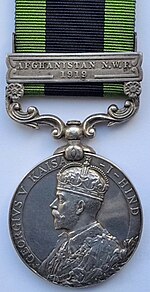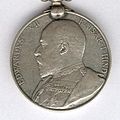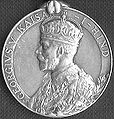Description
The medal is 36 millimetres (1.4 in) in diameter. It was struck at both the Calcutta and London mints, for Indian and British forces respectively. [3] For early campaigns it was awarded in silver to combatants and in bronze to native bearers and servants. From 1919 onwards all awards were in silver. [1]
The obverse shows the reigning monarch facing left with a suitable inscription. There are three versions: [3]
King Edward VII 1908-10
EDWARDVS VII KAISAR-I-HIND
King George V 1911-25
GEORGIVS V KAISAR-I-HIND
King George V 1930-35
GEORGIVS V DG BRITT OMN REX ET INDIAE IMP
The reverse depicts Jamrud Fort at the Khyber Pass with the word ‘India’ below between a wreath of oak and olive branches. [4]
The ribbon, 1.25 inches (32 mm) wide, was green with a broad blue central stripe. From 1920, those mentioned in despatches in a campaign for which the medal was awarded could wear a bronze oakleaf on the medal ribbon. [1]
The name and details of the recipient were engraved or impressed on the edge of the medal. [1]
Waziristan 1925
The Medal with the Waziristan 1925 clasp was awarded to only 46 officers and 214 men of the Royal Air Force, and 2 Indian Army Officers, who took part in Pink's War. It is, by far, the rarest clasp given with an India General Service Medal, with the exception of only 14 ‘Burma 1930-32’ clasps, awarded to the Royal Air Force, and was only awarded after the then Chief of the Air Staff, Sir John Salmond, succeeded in overturning the War Office decision not to grant a medal for Pink's War. [5] The ‘Waziristan 1925’ clasp, was not awarded to Royal Air Force personnel, who already had, or elected to have, the ‘Waziristan 1921-24’ clasp. For details, see ‘British Battles & Medals’, 7th. Edition.

The 1914 Star, colloquially known as the Mons Star, is a British First World War campaign medal for service in France or Belgium between 5 August and 22 November 1914.

The India General Service Medal was a campaign medal approved on 1 March 1854, for issue to officers and men of the British and Indian armies. It was awarded for various minor military campaigns in India and nearby countries, between 1852 and 1895.

The Indian General Service Medal was a campaign medal approved on 3 August 1938, for issue to officers and men of the British and Indian armies, and of the Royal Air Force.

The British War Medal is a campaign medal of the United Kingdom which was awarded to officers and men and women of British and Imperial forces for service in the First World War. Two versions of the medal were produced. About 6.5 million were struck in silver and 110,000 in bronze, the latter awarded to, among others, the Chinese, Maltese and Indian Labour Corps.
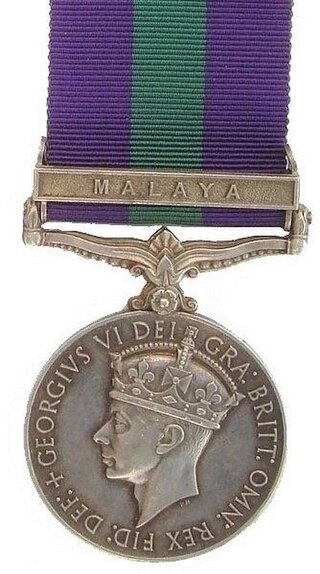
The General Service Medal was instituted to recognise service in minor Army and Royal Air Force operations for which no separate medal was intended. Local forces, including police, qualified for many of the clasps, as could units of the Indian Army prior to 1947.
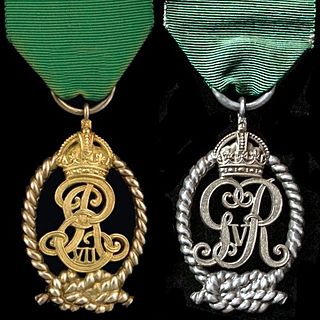
The Decoration for Officers of the Royal Naval Volunteer Reserve, post-nominal letters VD until c. 1947 and VRD thereafter, was instituted in 1908. It could be awarded to part-time commissioned officers in the United Kingdom's Royal Naval Volunteer Reserve after twenty years of service as efficient and thoroughly capable officers. The decoration was a Naval version of the Volunteer Officers' Decoration and its successor, the Territorial Decoration.

The India Medal was a campaign medal approved in 1896 for issue to officers and men of the British and Indian armies.

The Territorial Efficiency Medal (TEM) was a United Kingdom award for long service in the Territorial Army. It superseded the Territorial Force Efficiency Medal when the Territorial Force became the Territorial Army in 1921. It was superseded by the Efficiency Medal in 1930.
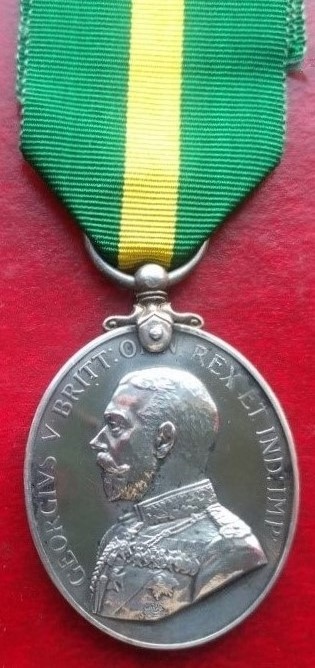
The Territorial Force Efficiency Medal was a United Kingdom award for long service in the Territorial Force between 1908 and 1921.
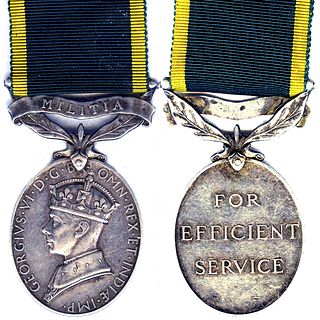
The Efficiency Medal was instituted in 1930 for award to part-time warrant officers, non-commissioned officers and men after twelve years of efficient service on the active list of the Militia or the Territorial Army of the United Kingdom, or of the other Auxiliary Military Forces throughout the British Empire. At the same time a clasp was instituted for award to holders of the medal upon completion of further periods of six years of efficient service.

Pink's War was an air-to-ground bombardment and strafing campaign carried out by the Royal Air Force, under the command of Wing Commander Richard Pink, against the mountain strongholds of Mahsud tribesmen in South Waziristan in March and April 1925. It was the first independent action by the RAF, and remains the only campaign named after an RAF officer.

The Meritorious Service Medal (MSM) is a British medal awarded to Senior Non Commissioned Officers and Warrant Officers of the British armed forces for long and meritorious service. From 1916 to 1928, eligibility was extended to cover both valuable services by selected other ranks irrespective of length of service, and for gallantry not in the face of the enemy.

Air Commodore Richard Charles Montagu Pink, was a senior officer in the Royal Air Force (RAF). He distinguished himself during service with the Royal Navy and Royal Naval Air Service in the First World War, before joining the RAF shortly after its creation in 1918. He is the namesake of Pink's War, which was the first campaign conducted by the RAF alone and the only campaign to be named after an RAF officer.
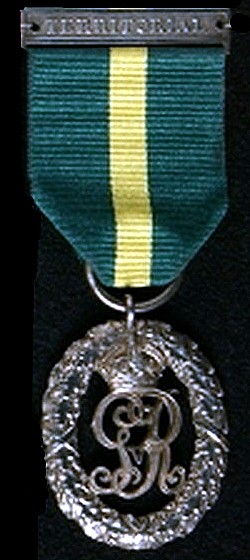
The Efficiency Decoration, post-nominal letters TD for recipients serving in the Territorial Army of the United Kingdom or ED for those serving in the Auxiliary Military Forces, was instituted in 1930 for award to part-time officers after twenty years of service as an efficient and thoroughly capable officer. The decoration superseded the Volunteer Officers' Decoration, the Colonial Auxiliary Forces Officers' Decoration and the Territorial Decoration.

The Waziristan campaign 1919–1920 was a military campaign conducted in Waziristan by British and Indian forces against the fiercely independent tribesmen that inhabited this region. These operations were conducted in 1919–1920, following the unrest that arose in the aftermath of the Third Anglo-Afghan War.
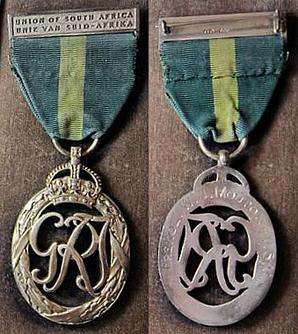
The Efficiency Decoration (South Africa), post-nominal letters ED, was instituted in 1930 for award to efficient and thoroughly capable part-time officers in the Citizen Force of the Union of South Africa after twenty years of service. The decoration superseded the Colonial Auxiliary Forces Officers' Decoration.

The Efficiency Medal (South Africa) was instituted in 1930 for award to part-time warrant officers, non-commissioned officers and men after twelve years of efficient service on the active list of the Citizen Force of the Union of South Africa. At the same time, a clasp was instituted for award to holders of the medal upon completion of further periods of six years of efficient service. The medal superseded the Colonial Auxiliary Forces Long Service Medal.

The Burma Gallantry Medal (BGM) was a military decoration awarded for acts of gallantry, in both war and peace, by Governor's commissioned officers, non-commissioned Officers and other ranks of the British Burmese military. These included its Army, Frontier Force, Military Police, Royal Naval Volunteer Reserve and Auxiliary Air Force. Clasps, attached to the ribbon, could be awarded to mark further awards of the medal.

The Royal Naval Volunteer Reserve Long Service and Good Conduct Medal, initially designated the Royal Naval Volunteer Reserve Long Service Medal, was instituted in 1908. It could be awarded to part-time ratings in the United Kingdom's Royal Naval Volunteer Reserve after twelve years of service and good conduct. The medal was a Naval version of the Volunteer Long Service Medal and its successor, the Territorial Force Efficiency Medal.

The Volunteer Long Service Medal was instituted in 1894 as an award for long service by other ranks and some officers of the United Kingdom's Volunteer Force. In 1896, the grant of the medal was extended to other ranks and officers who had served in the ranks of the Volunteer Forces throughout the British Empire. A separate new medal was instituted, the Volunteer Long Service Medal for India and the Colonies. Awarding of this medal was discontinued in stages when it was superseded in most territories by the Colonial Auxiliary Forces Long Service Medal in 1899 and in the remainder by the Efficiency Medal in 1930.
